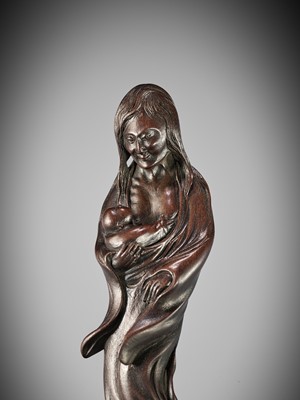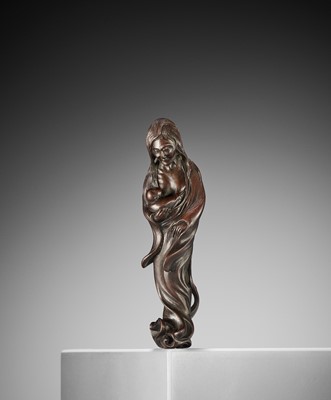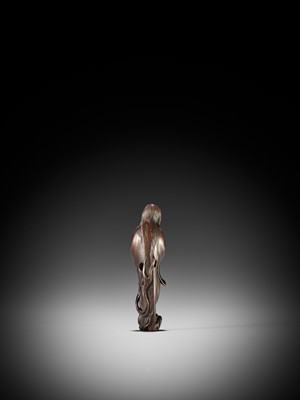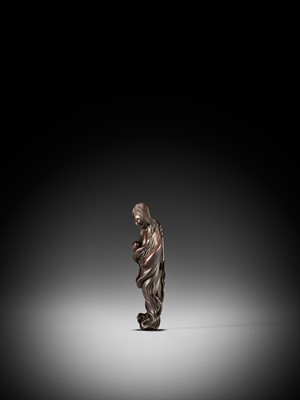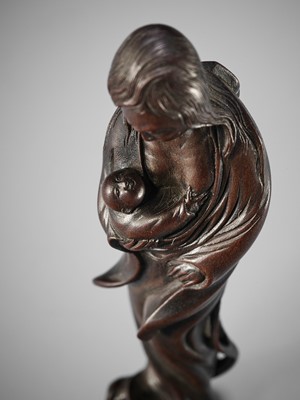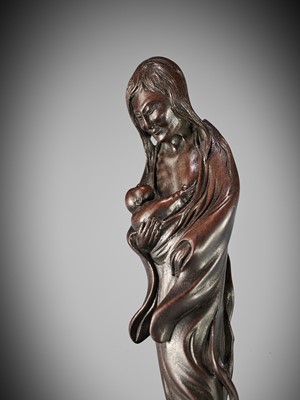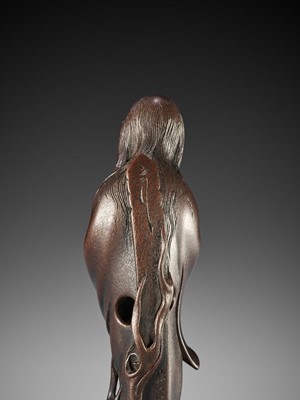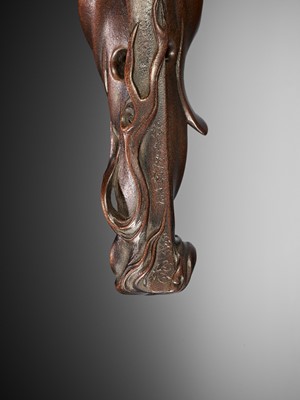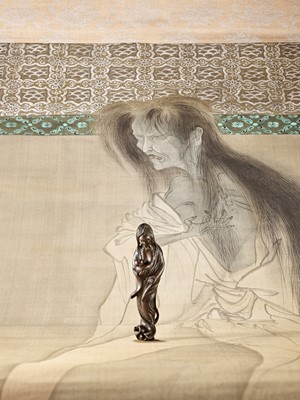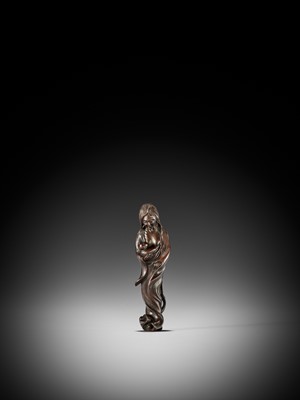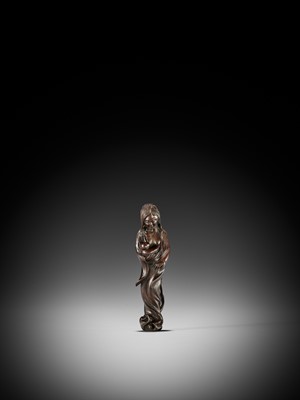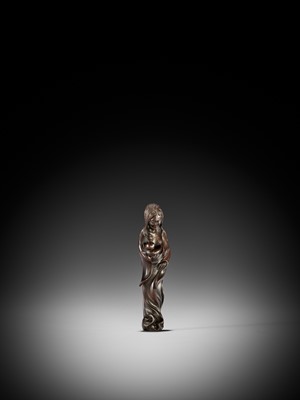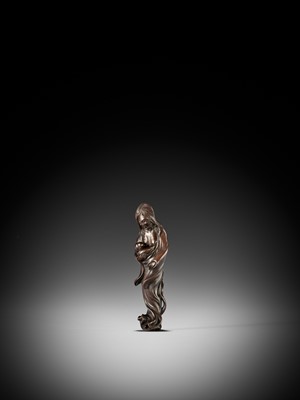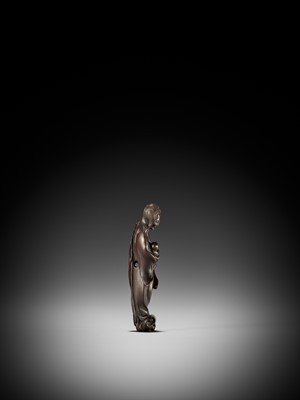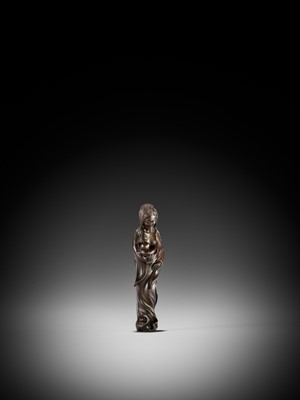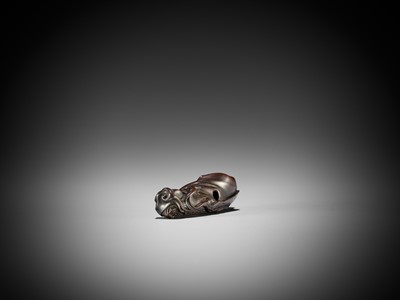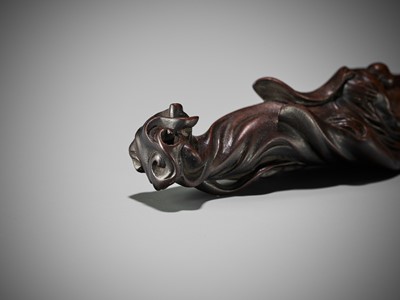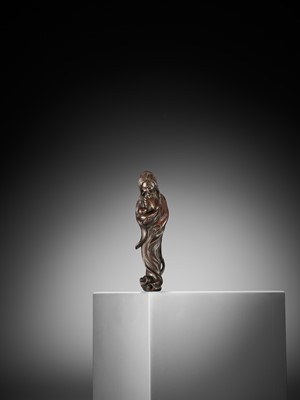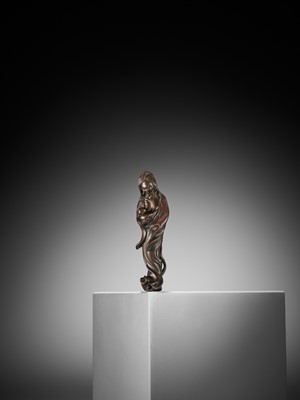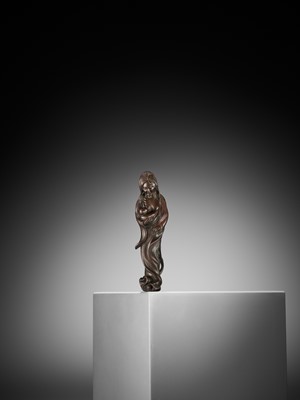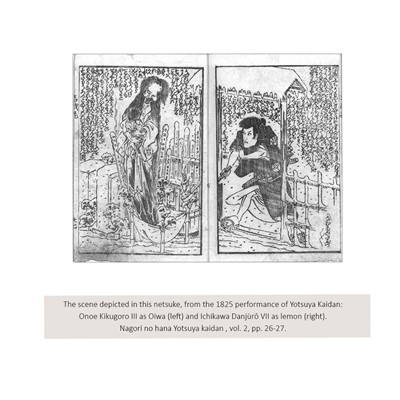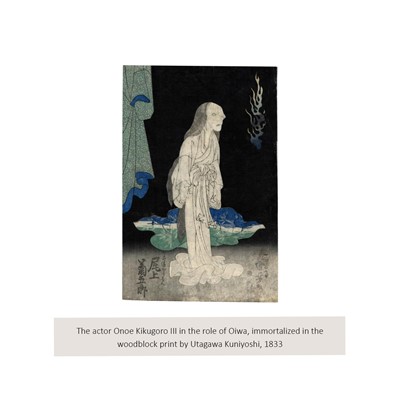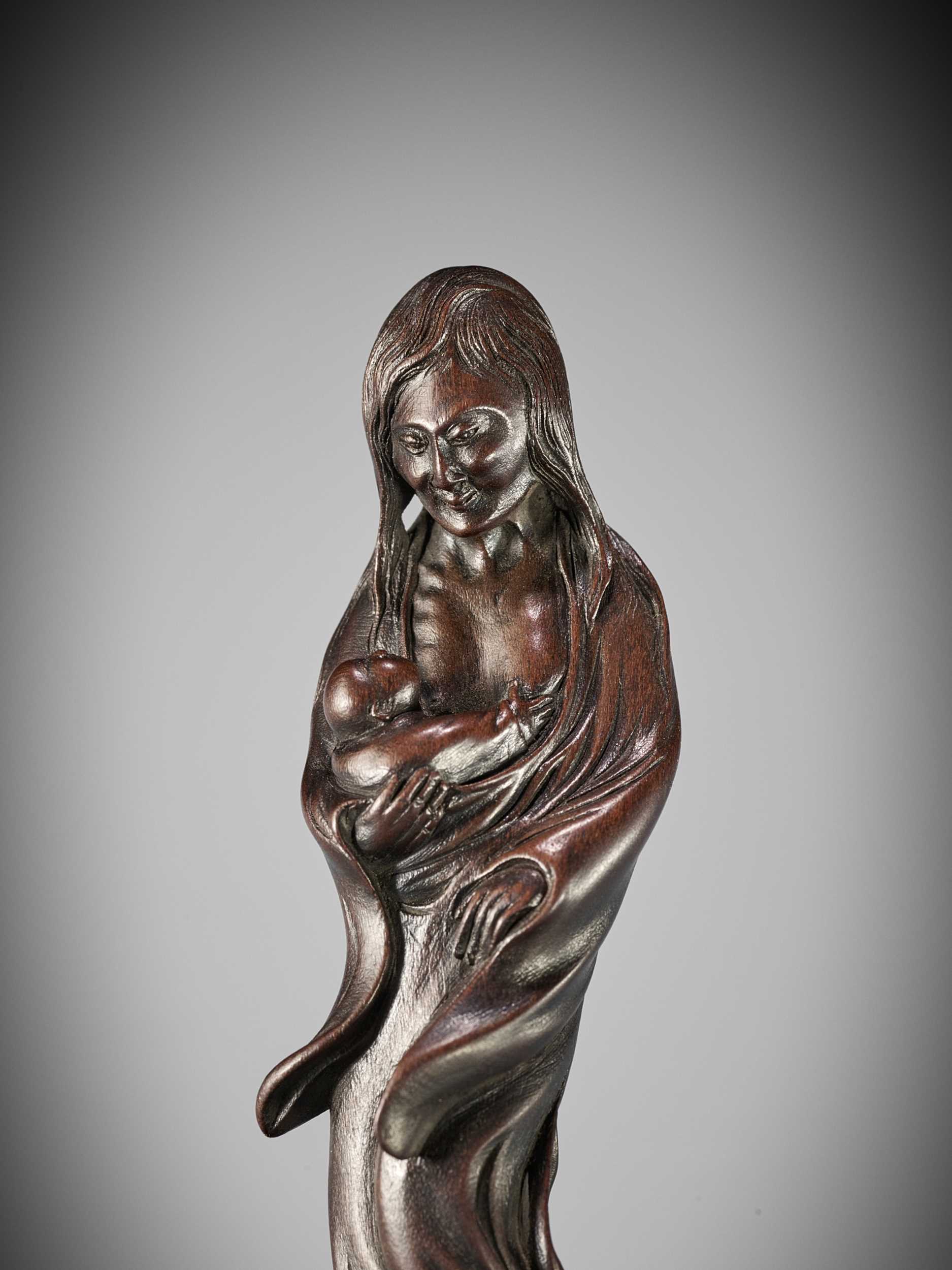27th May, 2022 13:00
Fine Japanese Art
146
JUGYOKU: AN IMPORTANT AND MASTERFUL WOOD NETSUKE OF THE FEMALE GHOST OIWA WITH CHILD, COMMISSIONED FOR THE FAMOUS KABUKI ACTOR ONOE BAIKO
Sold for €20,224
including Buyer's Premium
By Ryukosai Jugyoku, signed Jugyoku saku and with inscription
Japan, Edo (Tokyo), c. 1830, Edo period (1615-1868)
Superbly carved as the ghost Oiwa-san emerging from ghastly flames, her body twisting and robes flowing. Her bony fingers are finely shaped, one hand is cradling an infant which is nestled into her loose-fitted robe, gently pressed against her stomach, one of the baby’s hands grabbing one of her breasts. Note the subtly incised rib cage and neck bones. Oiwa is looking at the child with motherly compassion, the infant in return looks up at the ghost yearningly. The superbly carved backside shows neatly incised trailing hair and a grave post (sotoba) engulfed by more ghastly flames and the minutely incised inscription as well as the signature JUGYOKU saku [made by Jugyoku].
The inscription reads: 梅幸丈好應、寿玉作 “Baiko-jo konomi ni ojite, Jugyoku saku” [Made by Jugyoku by the request of Master Onoe Baiko” The word “Jo 丈” is an honorific suffix given to Kabuki actors. According to the inscription in the back, this netsuke was commissioned by the famous Kabuki actor Onoe Baiko – there are many generations of the same name but it most likely refers to Onoe Kikugoro III (active as Baiko III).
This netsuke depicts a legendary and controversial scene in the fifth and final act of the famous kabuki play Yotsuya Kaidan by Tsuruya Nanboku IV. In this scene, Oiwa emerges in the form of an Ubume from a consecration cloth, holding her child in her arms. An Ubume is a type of ghost associated with pregnancy and childbirth. Depicting Oiwa as an Ubume was considered highly audacious, because Oiwa had murdered her own child. With depictions of ubume being ubiquitous at the time, the unusual twist had an immense impact on the audience, and it ultimately defined the stardom of Onoe Kikugorō III (1784-1849), who was the only actor ever to play Oiwa in it.
The scene was dropped after the first production in 1825 amid fierce debate and replaced with a special effect in which Oiwa emerges from a burning lantern. For further reading on the cultural significance of this scene see Shimazaki, Satoko (2011) The End of the "World": Tsuruya Nanboku IV's Female Ghosts and Late-Tokugawa Kabuki.
HEIGHT 7.8 cm
Condition: Excellent condition.
Provenance: From a noted Swiss private collection.
Tsuruya Nanboku IV, the playwright of the famous Yotsuya Kaidan, wrote the role of Oiwa specifically for his friend Onoe Kikugoro III (Baiko III), who played the lead role during this famous kabuki play’s debut in 1825. It is most likely that this netsuke was commissioned both as a as a talisman (engimono 縁起物), because kabuki actors playing ghosts-roles were thought to be haunted and accident-prone, and as a commemorative gift to remind of the legendary scene in the fifth and final act which had only been performed in the introducing season of the play.
Onoe Kikugoro III (1784-1849) was one of the most talented actors of his age. He was adopted into the Onoe lineage of actors and made his debut at the age of four under the name Onoe Eisaburo I. After playing the parts of young men, he assumed the name of his adoptive father in 1809, becoming Onoe Matsusuke II. In 1814 he appeared as Onoe Baiko, and a year later his reputation was such that he became the first actor for almost 30 years to succeed to the Kikugoro name, becoming Onoe Kikugoro III, although he retained the name Baiko to sign his poetry. He is best remembered for his alliance with the playwright Tsuruya Nanboku IV, who in 1825 wrote the role of Oiwa in Yotsuya Kaidan, the best known of all Kabuki ghost plays, specifically for him.
Yotsuya Kaidan, the story of Oiwa and Tamiya Iemon, is a tale of betrayal, murder and ghostly revenge. Arguably the most famous Japanese ghost story of all time, it has been adapted for film over 30 times and continues to be of a major influence on Japanese horror stories of the present day.
Ryukosai Jugyoku, the carver of this netsuke, was likely provided with an immense challenge, given the notorious prominence of this specific depiction of Oiwa. A generous commission, and being able to work for one of the biggest kabuki-stars of all times, must have had a stimulating effect on the artist. Arguably, he eventually surpassed himself with the present work, which certainly must be considered as this carver’s masterpiece.
Not only is the present lot exemplary of the very finest carvings of its era, and by one of its most talented artists, but the absolutely unique historic angle, confirmed by an inscription, makes this sublime work of art one of the most important netsuke to ever appear on the market.
By Ryukosai Jugyoku, signed Jugyoku saku and with inscription
Japan, Edo (Tokyo), c. 1830, Edo period (1615-1868)
Superbly carved as the ghost Oiwa-san emerging from ghastly flames, her body twisting and robes flowing. Her bony fingers are finely shaped, one hand is cradling an infant which is nestled into her loose-fitted robe, gently pressed against her stomach, one of the baby’s hands grabbing one of her breasts. Note the subtly incised rib cage and neck bones. Oiwa is looking at the child with motherly compassion, the infant in return looks up at the ghost yearningly. The superbly carved backside shows neatly incised trailing hair and a grave post (sotoba) engulfed by more ghastly flames and the minutely incised inscription as well as the signature JUGYOKU saku [made by Jugyoku].
The inscription reads: 梅幸丈好應、寿玉作 “Baiko-jo konomi ni ojite, Jugyoku saku” [Made by Jugyoku by the request of Master Onoe Baiko” The word “Jo 丈” is an honorific suffix given to Kabuki actors. According to the inscription in the back, this netsuke was commissioned by the famous Kabuki actor Onoe Baiko – there are many generations of the same name but it most likely refers to Onoe Kikugoro III (active as Baiko III).
This netsuke depicts a legendary and controversial scene in the fifth and final act of the famous kabuki play Yotsuya Kaidan by Tsuruya Nanboku IV. In this scene, Oiwa emerges in the form of an Ubume from a consecration cloth, holding her child in her arms. An Ubume is a type of ghost associated with pregnancy and childbirth. Depicting Oiwa as an Ubume was considered highly audacious, because Oiwa had murdered her own child. With depictions of ubume being ubiquitous at the time, the unusual twist had an immense impact on the audience, and it ultimately defined the stardom of Onoe Kikugorō III (1784-1849), who was the only actor ever to play Oiwa in it.
The scene was dropped after the first production in 1825 amid fierce debate and replaced with a special effect in which Oiwa emerges from a burning lantern. For further reading on the cultural significance of this scene see Shimazaki, Satoko (2011) The End of the "World": Tsuruya Nanboku IV's Female Ghosts and Late-Tokugawa Kabuki.
HEIGHT 7.8 cm
Condition: Excellent condition.
Provenance: From a noted Swiss private collection.
Tsuruya Nanboku IV, the playwright of the famous Yotsuya Kaidan, wrote the role of Oiwa specifically for his friend Onoe Kikugoro III (Baiko III), who played the lead role during this famous kabuki play’s debut in 1825. It is most likely that this netsuke was commissioned both as a as a talisman (engimono 縁起物), because kabuki actors playing ghosts-roles were thought to be haunted and accident-prone, and as a commemorative gift to remind of the legendary scene in the fifth and final act which had only been performed in the introducing season of the play.
Onoe Kikugoro III (1784-1849) was one of the most talented actors of his age. He was adopted into the Onoe lineage of actors and made his debut at the age of four under the name Onoe Eisaburo I. After playing the parts of young men, he assumed the name of his adoptive father in 1809, becoming Onoe Matsusuke II. In 1814 he appeared as Onoe Baiko, and a year later his reputation was such that he became the first actor for almost 30 years to succeed to the Kikugoro name, becoming Onoe Kikugoro III, although he retained the name Baiko to sign his poetry. He is best remembered for his alliance with the playwright Tsuruya Nanboku IV, who in 1825 wrote the role of Oiwa in Yotsuya Kaidan, the best known of all Kabuki ghost plays, specifically for him.
Yotsuya Kaidan, the story of Oiwa and Tamiya Iemon, is a tale of betrayal, murder and ghostly revenge. Arguably the most famous Japanese ghost story of all time, it has been adapted for film over 30 times and continues to be of a major influence on Japanese horror stories of the present day.
Ryukosai Jugyoku, the carver of this netsuke, was likely provided with an immense challenge, given the notorious prominence of this specific depiction of Oiwa. A generous commission, and being able to work for one of the biggest kabuki-stars of all times, must have had a stimulating effect on the artist. Arguably, he eventually surpassed himself with the present work, which certainly must be considered as this carver’s masterpiece.
Not only is the present lot exemplary of the very finest carvings of its era, and by one of its most talented artists, but the absolutely unique historic angle, confirmed by an inscription, makes this sublime work of art one of the most important netsuke to ever appear on the market.
Zacke Live Online Bidding
Our online bidding platform makes it easier than ever to bid in our auctions! When you bid through our website, you can take advantage of our premium buyer's terms without incurring any additional online bidding surcharges.
To bid live online, you'll need to create an online account. Once your account is created and your identity is verified, you can register to bid in an auction up to 12 hours before the auction begins.
Intended Spend and Bid Limits
When you register to bid in an online auction, you will need to share your intended maximum spending budget for the auction. We will then review your intended spend and set a bid limit for you. Once you have pre-registered for a live online auction, you can see your intended spend and bid limit by going to 'Account Settings' and clicking on 'Live Bidding Registrations'.
Your bid limit will be the maximum amount you can bid during the auction. Your bid limit is for the hammer price and is not affected by the buyer’s premium and VAT. For example, if you have a bid limit of €1,000 and place two winning bids for €300 and €200, then you will only be able to bid €500 for the rest of the auction. If you try to place a bid that is higher than €500, you will not be able to do so.
Online Absentee and Telephone Bids
You can now leave absentee and telephone bids on our website!
Absentee Bidding
Once you've created an account and your identity is verified, you can leave your absentee bid directly on the lot page. We will contact you when your bids have been confirmed.
Telephone Bidding
Once you've created an account and your identity is verified, you can leave telephone bids online. We will contact you when your bids have been confirmed.
Classic Absentee and Telephone Bidding Form
You can still submit absentee and telephone bids by email or fax if you prefer. Simply fill out the Absentee Bidding/Telephone bidding form and return it to us by email at office@zacke.at or by fax at +43 (1) 532 04 52 20. You can download the PDF from our Upcoming Auctions page.
How-To Guides
How to Create Your Personal Zacke Account
How to Register to Bid on Zacke Live
How to Leave Absentee Bids Online
How to Leave Telephone Bids Online
中文版本的操作指南
创建新账号
注册Zacke Live在线直播竞拍(免平台费)
缺席投标和电话投标
Third-Party Bidding
We partner with best-in-class third-party partners to make it easy for you to bid online in the channel of your choice. Please note that if you bid with one of our third-party online partners, then there will be a live bidding surcharge on top of your final purchase price. You can find all of our fees here. Here's a full list of our third-party partners:
- 51 Bid Live
- EpaiLive
- ArtFoxLive
- Invaluable
- LiveAuctioneers
- the-saleroom
- lot-tissimo
- Drouot
Please note that we place different auctions on different platforms. For example, in general, we only place Chinese art auctions on 51 Bid Live.
Bidding in Person
You must register to bid in person and will be assigned a paddle at the auction. Please contact us at office@zacke.at or +43 (1) 532 04 52 for the latest local health and safety guidelines.
